
Natural Resources
Conservation Service
Ecological site AX002X02X007
Portland Basin Wet Forest
Last updated: 12/09/2024
Accessed: 12/21/2025
General information
Provisional. A provisional ecological site description has undergone quality control and quality assurance review. It contains a working state and transition model and enough information to identify the ecological site.
MLRA notes
Major Land Resource Area (MLRA): 002X–Willamette and Puget Sound Valleys
The Willamette and Puget Sound Valleys Major Land Resource Area (MLRA 2) is in western parts of Washington and Oregon. It occupies a forearc basin between the Coast Ranges and the Cascade Mountain volcanic arc. The northern part contains Pleistocene drift, outwash, and lacustrine and glaciomarine deposits associated with continental glaciers. The southern part contains Late Pleistocene deposits from glacial outburst floods (Missoula Floods).
Climate is mild and moist, and the growing season is long. Mean annual precipitation ranges from 20 to 60 inches, received mostly in fall, winter, and spring. Summers are dry. The soil temperature regime is mesic, and the soil moisture regimes are xeric and aquic.
Most sites in this MLRA can support forested vegetation, but some were maintained as prairie, savanna, or woodland through cultural burning prior to Euro-American settlement. Puget Sound has a moderating effect on temperatures, and humidity can be higher in the northern part of the MLRA. Douglas-fir (Pseudotsuga menziesii) is widespread throughout. Oregon white oak (Quercus garryana) is common on uplands in the south and on warm, exposed or droughty sites in the north. Pacific madrone grows in areas close to saltwater. Western hemlock (Tsuga heterophylla) is codominant with Douglas-fir in the north. Flood plains typically contain Brayshaw black cottonwood (Populus balsamifera ssp. trichocarpa) and red alder (Alnus rubra). Oregon ash (Fraxinus latifolia) is typical of forested wetlands in the south.
Forestry, urban development, and cultivated agriculture are currently the most extensive land uses (USDA, Agriculture Handbook 296, 2022).
LRU notes
The Portland Basin and Hills Land Resource Unit (LRU B) is in southwestern Washington and northwestern Oregon. The LRU extends north to the Cowlitz River and transitions to the Willamette Valley in the south. The Columbia River Gorge limits the eastern extent, and influence of tidewater at Cathlamet identifies the northwestern extent. Elevation ranges from sea level to about 2,000 feet. Major landforms include glaciofluvial terraces along the Columbia River, as well as residual hills and foothills surrounding the basin. Minor areas of Columbia River flood plain are present in Washington and more extensively in Oregon. Residual hills are composed primarily of Quaternary-Pliocene and Tertiary volcanic and sedimentary rocks. The lower-relief basin is composed primarily of sediment from catastrophic Quaternary glacial flooding from Glacial Lake Missoula.
The Columbia River splits this LRU between Oregon and Washington.
In Washington, mean annual precipitation ranges from 35 to 60 inches. Most falls as rain between October and May. The frost-free period ranges from 160 to 220 days. Locations near the Columbia River Gorge experience strong winds and infrequent ice storms with little winter snow. Average daily maximum temperatures in summer at Vancouver, Washington, are 1 to 3 degrees F warmer compared to Seattle or Olympia, Washington (Agricultural Climate Information System, 2007a, 2007b).
Oregon white oak and Douglas-fir are common north of the Columbia River in Washington. Western redcedar and western hemlock grow in areas of higher moisture, at higher elevations, or on protected aspects.
Classification relationships
Relationship to Other Established Classifications:
Washington Department of Natural Resources, Ecological Systems of Washington State: North Pacific Hardwood-Conifer Swamp
Ecological site concept
This ecological site consists of forested wetlands in depressions and drainageways. The site is affected by a seasonal high water table. The site is strongly influenced by physiography and hydrology, which provide rare and unique habitats in Puget Sound. The climate has warm, moist summers and cool, wet winters. Precipitation falls mostly as rain. Snow is rare. Soils that support this ecological site are in the mesic soil temperature regime and aquic soil moisture regime. Most areas of this site can be subject to residual ponding in addition to extended periods of water at the surface. These anaerobic conditions can lead to a slowed rate of organic decomposition. The seasonal high water table and ponding dynamics may be altered by artificial drainage of the site or adjacent areas. A thin organic horizon consisting of decomposing twigs, needles, and litter is on the surface. This horizon helps to protect the soils from wind and water erosion.
This site can be compared to the Puget Lowlands Wet Forest site in LRU A, which is similar but has lower summer temperatures and higher amounts of summer precipitation. The climate may be moister during the growing season in LRU A, leading to a shorter recovery between disturbances than in LRU B.
Associated sites
| AX002X02X008 |
Portland Basin Riparian Forest |
|---|---|
| AX002X02X003 |
Portland Basin Bogs and Fens |
Similar sites
| F002XN904WA |
Sitka spruce - red alder/salmonberry/field horsetail |
|---|---|
| AX002X01X007 |
Puget Lowlands Wet Hemlock Forest |
Table 1. Dominant plant species
| Tree |
(1) Tsuga heterophylla |
|---|---|
| Shrub |
(1) Rubus spectabilis |
| Herbaceous |
(1) Lysichiton americanus |
Legacy ID
F002XB007WA
Click on box and path labels to scroll to the respective text.
